University Assignment: Kotter's Leading Change Case Study Analysis
VerifiedAdded on 2022/07/28
|11
|3143
|454
Report
AI Summary
This report offers a comprehensive analysis of John Kotter's Leading Change model, examining its underlying assumptions about people and organizational management. It connects Kotter's framework with various schools of management thought, including Nudge theory, Lewin's theory, scientific management, and administrative management. The report then applies Kotter's 8-step transformation process to a real-world organizational change initiative, evaluating its effectiveness, strengths, and limitations. Furthermore, the report delves into a case study of Shell's Downstream One project, identifying stakeholders and analyzing their sources of power. The analysis covers customers, employees, shareholders, distributors, local communities, and IT professionals, along with software companies like IBM and SAP, examining their influence on the initiative's success. The report concludes by highlighting the strengths of the model, such as its structured approach, and its limitations, including its mechanistic nature and potential lack of emotional consideration.
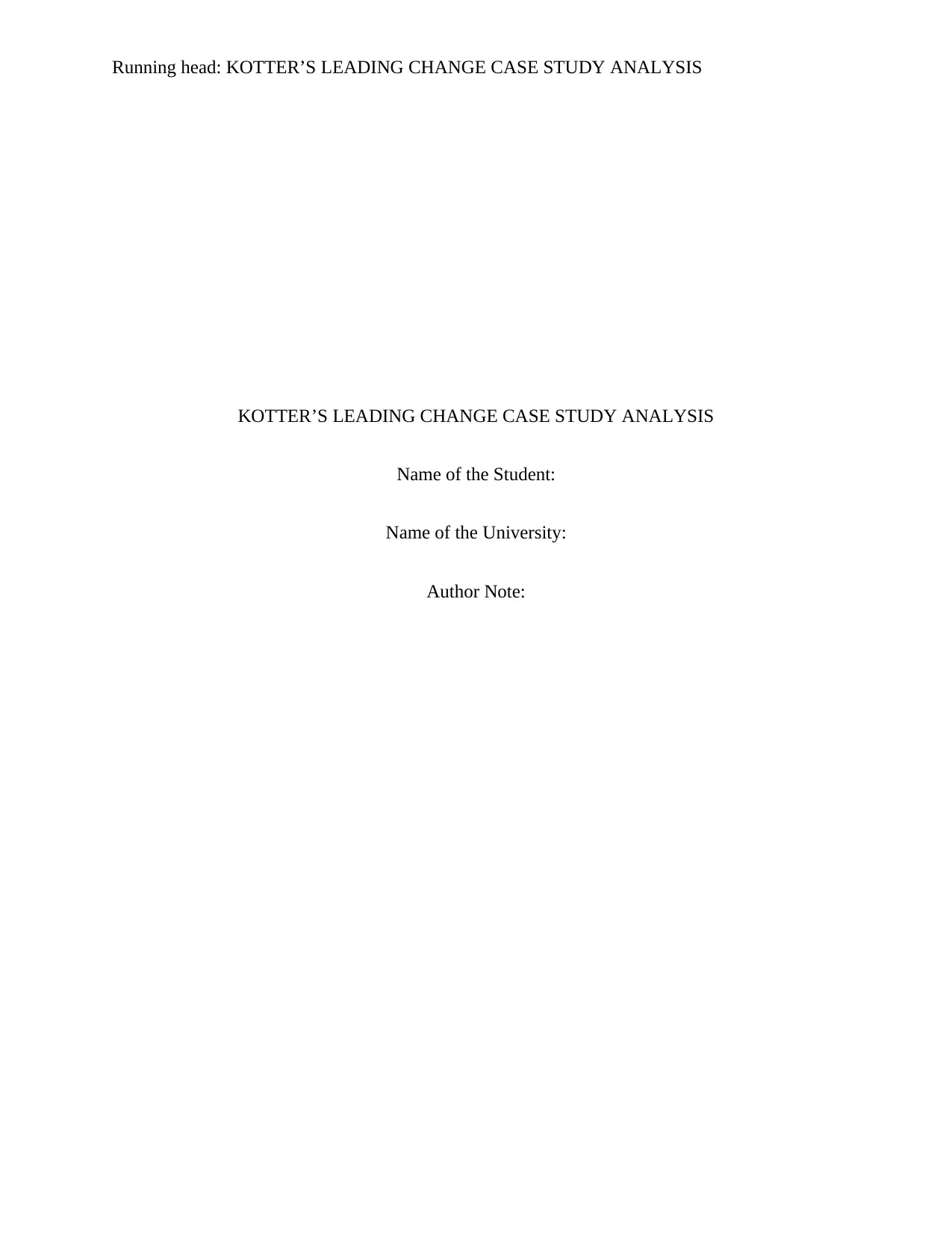
Running head: KOTTER’S LEADING CHANGE CASE STUDY ANALYSIS
KOTTER’S LEADING CHANGE CASE STUDY ANALYSIS
Name of the Student:
Name of the University:
Author Note:
KOTTER’S LEADING CHANGE CASE STUDY ANALYSIS
Name of the Student:
Name of the University:
Author Note:
Paraphrase This Document
Need a fresh take? Get an instant paraphrase of this document with our AI Paraphraser
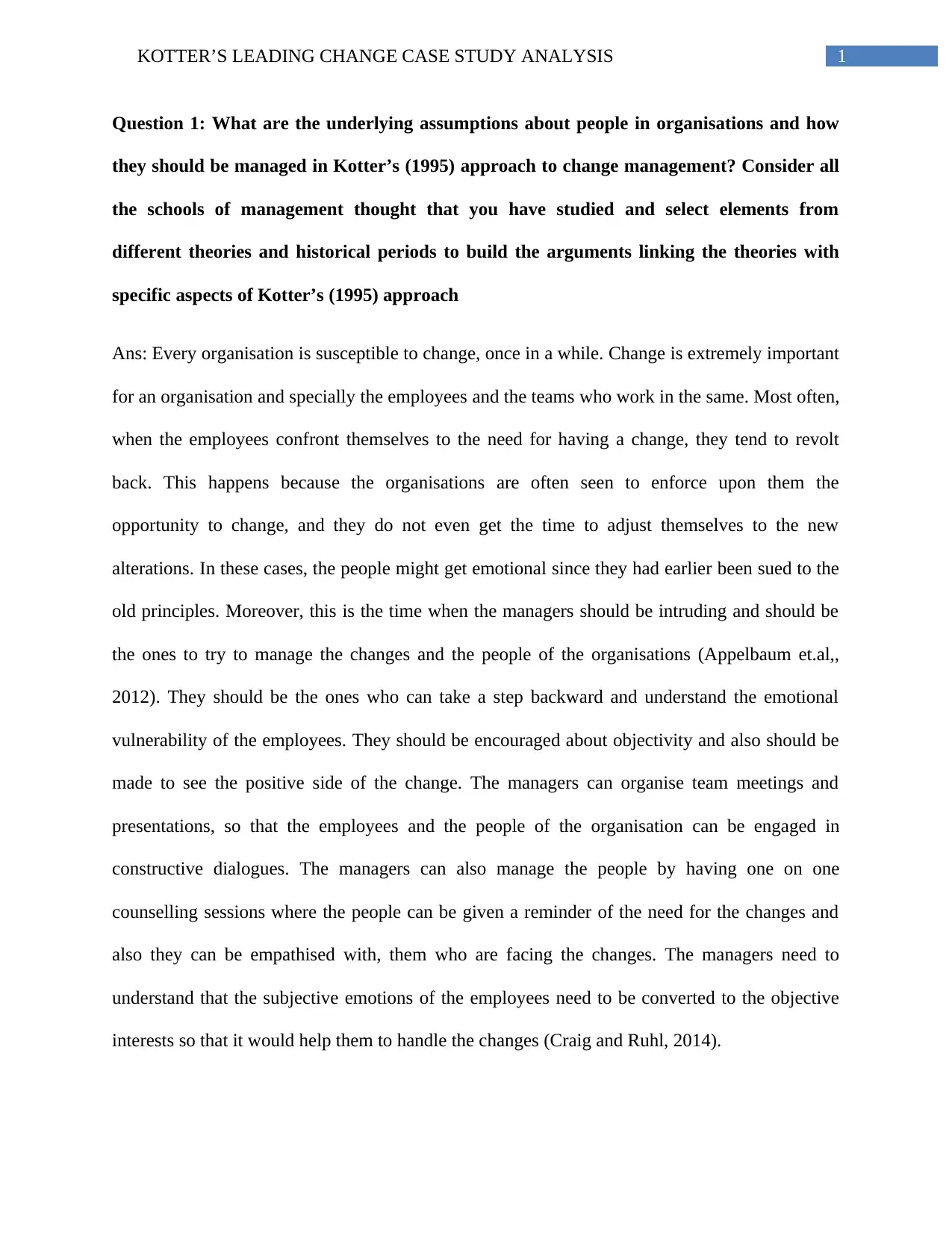
1KOTTER’S LEADING CHANGE CASE STUDY ANALYSIS
Question 1: What are the underlying assumptions about people in organisations and how
they should be managed in Kotter’s (1995) approach to change management? Consider all
the schools of management thought that you have studied and select elements from
different theories and historical periods to build the arguments linking the theories with
specific aspects of Kotter’s (1995) approach
Ans: Every organisation is susceptible to change, once in a while. Change is extremely important
for an organisation and specially the employees and the teams who work in the same. Most often,
when the employees confront themselves to the need for having a change, they tend to revolt
back. This happens because the organisations are often seen to enforce upon them the
opportunity to change, and they do not even get the time to adjust themselves to the new
alterations. In these cases, the people might get emotional since they had earlier been sued to the
old principles. Moreover, this is the time when the managers should be intruding and should be
the ones to try to manage the changes and the people of the organisations (Appelbaum et.al,,
2012). They should be the ones who can take a step backward and understand the emotional
vulnerability of the employees. They should be encouraged about objectivity and also should be
made to see the positive side of the change. The managers can organise team meetings and
presentations, so that the employees and the people of the organisation can be engaged in
constructive dialogues. The managers can also manage the people by having one on one
counselling sessions where the people can be given a reminder of the need for the changes and
also they can be empathised with, them who are facing the changes. The managers need to
understand that the subjective emotions of the employees need to be converted to the objective
interests so that it would help them to handle the changes (Craig and Ruhl, 2014).
Question 1: What are the underlying assumptions about people in organisations and how
they should be managed in Kotter’s (1995) approach to change management? Consider all
the schools of management thought that you have studied and select elements from
different theories and historical periods to build the arguments linking the theories with
specific aspects of Kotter’s (1995) approach
Ans: Every organisation is susceptible to change, once in a while. Change is extremely important
for an organisation and specially the employees and the teams who work in the same. Most often,
when the employees confront themselves to the need for having a change, they tend to revolt
back. This happens because the organisations are often seen to enforce upon them the
opportunity to change, and they do not even get the time to adjust themselves to the new
alterations. In these cases, the people might get emotional since they had earlier been sued to the
old principles. Moreover, this is the time when the managers should be intruding and should be
the ones to try to manage the changes and the people of the organisations (Appelbaum et.al,,
2012). They should be the ones who can take a step backward and understand the emotional
vulnerability of the employees. They should be encouraged about objectivity and also should be
made to see the positive side of the change. The managers can organise team meetings and
presentations, so that the employees and the people of the organisation can be engaged in
constructive dialogues. The managers can also manage the people by having one on one
counselling sessions where the people can be given a reminder of the need for the changes and
also they can be empathised with, them who are facing the changes. The managers need to
understand that the subjective emotions of the employees need to be converted to the objective
interests so that it would help them to handle the changes (Craig and Ruhl, 2014).
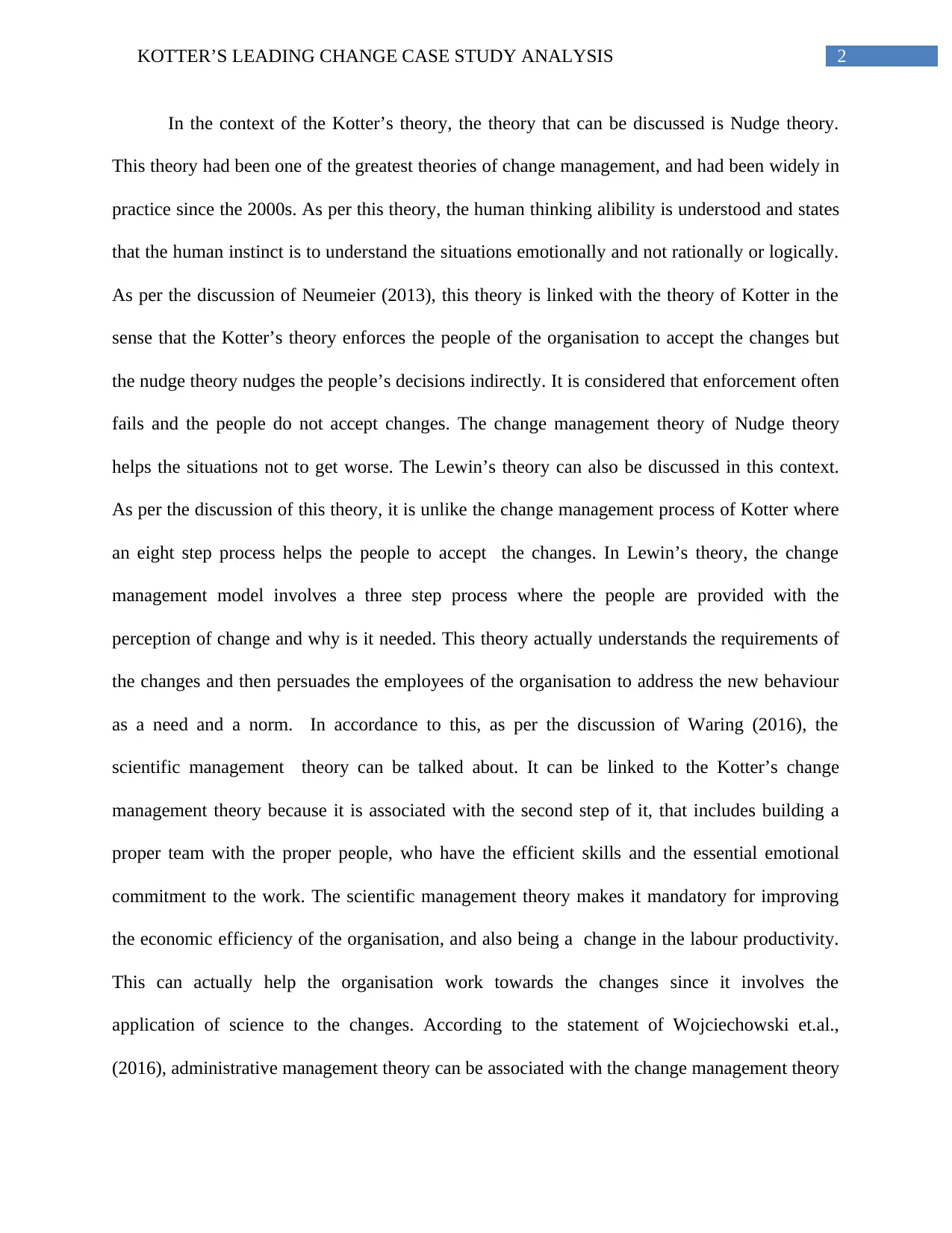
2KOTTER’S LEADING CHANGE CASE STUDY ANALYSIS
In the context of the Kotter’s theory, the theory that can be discussed is Nudge theory.
This theory had been one of the greatest theories of change management, and had been widely in
practice since the 2000s. As per this theory, the human thinking alibility is understood and states
that the human instinct is to understand the situations emotionally and not rationally or logically.
As per the discussion of Neumeier (2013), this theory is linked with the theory of Kotter in the
sense that the Kotter’s theory enforces the people of the organisation to accept the changes but
the nudge theory nudges the people’s decisions indirectly. It is considered that enforcement often
fails and the people do not accept changes. The change management theory of Nudge theory
helps the situations not to get worse. The Lewin’s theory can also be discussed in this context.
As per the discussion of this theory, it is unlike the change management process of Kotter where
an eight step process helps the people to accept the changes. In Lewin’s theory, the change
management model involves a three step process where the people are provided with the
perception of change and why is it needed. This theory actually understands the requirements of
the changes and then persuades the employees of the organisation to address the new behaviour
as a need and a norm. In accordance to this, as per the discussion of Waring (2016), the
scientific management theory can be talked about. It can be linked to the Kotter’s change
management theory because it is associated with the second step of it, that includes building a
proper team with the proper people, who have the efficient skills and the essential emotional
commitment to the work. The scientific management theory makes it mandatory for improving
the economic efficiency of the organisation, and also being a change in the labour productivity.
This can actually help the organisation work towards the changes since it involves the
application of science to the changes. According to the statement of Wojciechowski et.al.,
(2016), administrative management theory can be associated with the change management theory
In the context of the Kotter’s theory, the theory that can be discussed is Nudge theory.
This theory had been one of the greatest theories of change management, and had been widely in
practice since the 2000s. As per this theory, the human thinking alibility is understood and states
that the human instinct is to understand the situations emotionally and not rationally or logically.
As per the discussion of Neumeier (2013), this theory is linked with the theory of Kotter in the
sense that the Kotter’s theory enforces the people of the organisation to accept the changes but
the nudge theory nudges the people’s decisions indirectly. It is considered that enforcement often
fails and the people do not accept changes. The change management theory of Nudge theory
helps the situations not to get worse. The Lewin’s theory can also be discussed in this context.
As per the discussion of this theory, it is unlike the change management process of Kotter where
an eight step process helps the people to accept the changes. In Lewin’s theory, the change
management model involves a three step process where the people are provided with the
perception of change and why is it needed. This theory actually understands the requirements of
the changes and then persuades the employees of the organisation to address the new behaviour
as a need and a norm. In accordance to this, as per the discussion of Waring (2016), the
scientific management theory can be talked about. It can be linked to the Kotter’s change
management theory because it is associated with the second step of it, that includes building a
proper team with the proper people, who have the efficient skills and the essential emotional
commitment to the work. The scientific management theory makes it mandatory for improving
the economic efficiency of the organisation, and also being a change in the labour productivity.
This can actually help the organisation work towards the changes since it involves the
application of science to the changes. According to the statement of Wojciechowski et.al.,
(2016), administrative management theory can be associated with the change management theory
⊘ This is a preview!⊘
Do you want full access?
Subscribe today to unlock all pages.

Trusted by 1+ million students worldwide
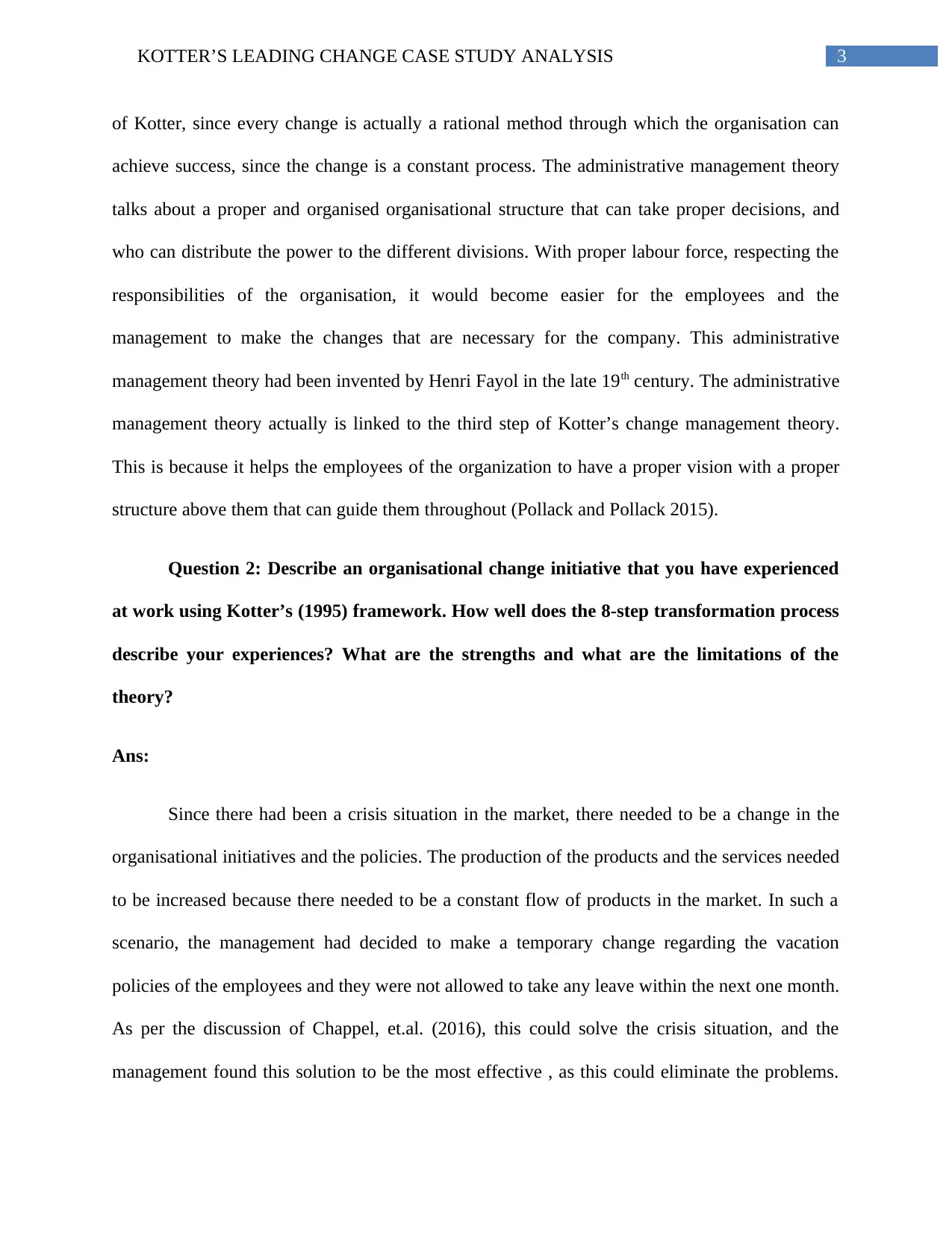
3KOTTER’S LEADING CHANGE CASE STUDY ANALYSIS
of Kotter, since every change is actually a rational method through which the organisation can
achieve success, since the change is a constant process. The administrative management theory
talks about a proper and organised organisational structure that can take proper decisions, and
who can distribute the power to the different divisions. With proper labour force, respecting the
responsibilities of the organisation, it would become easier for the employees and the
management to make the changes that are necessary for the company. This administrative
management theory had been invented by Henri Fayol in the late 19th century. The administrative
management theory actually is linked to the third step of Kotter’s change management theory.
This is because it helps the employees of the organization to have a proper vision with a proper
structure above them that can guide them throughout (Pollack and Pollack 2015).
Question 2: Describe an organisational change initiative that you have experienced
at work using Kotter’s (1995) framework. How well does the 8-step transformation process
describe your experiences? What are the strengths and what are the limitations of the
theory?
Ans:
Since there had been a crisis situation in the market, there needed to be a change in the
organisational initiatives and the policies. The production of the products and the services needed
to be increased because there needed to be a constant flow of products in the market. In such a
scenario, the management had decided to make a temporary change regarding the vacation
policies of the employees and they were not allowed to take any leave within the next one month.
As per the discussion of Chappel, et.al. (2016), this could solve the crisis situation, and the
management found this solution to be the most effective , as this could eliminate the problems.
of Kotter, since every change is actually a rational method through which the organisation can
achieve success, since the change is a constant process. The administrative management theory
talks about a proper and organised organisational structure that can take proper decisions, and
who can distribute the power to the different divisions. With proper labour force, respecting the
responsibilities of the organisation, it would become easier for the employees and the
management to make the changes that are necessary for the company. This administrative
management theory had been invented by Henri Fayol in the late 19th century. The administrative
management theory actually is linked to the third step of Kotter’s change management theory.
This is because it helps the employees of the organization to have a proper vision with a proper
structure above them that can guide them throughout (Pollack and Pollack 2015).
Question 2: Describe an organisational change initiative that you have experienced
at work using Kotter’s (1995) framework. How well does the 8-step transformation process
describe your experiences? What are the strengths and what are the limitations of the
theory?
Ans:
Since there had been a crisis situation in the market, there needed to be a change in the
organisational initiatives and the policies. The production of the products and the services needed
to be increased because there needed to be a constant flow of products in the market. In such a
scenario, the management had decided to make a temporary change regarding the vacation
policies of the employees and they were not allowed to take any leave within the next one month.
As per the discussion of Chappel, et.al. (2016), this could solve the crisis situation, and the
management found this solution to be the most effective , as this could eliminate the problems.
Paraphrase This Document
Need a fresh take? Get an instant paraphrase of this document with our AI Paraphraser
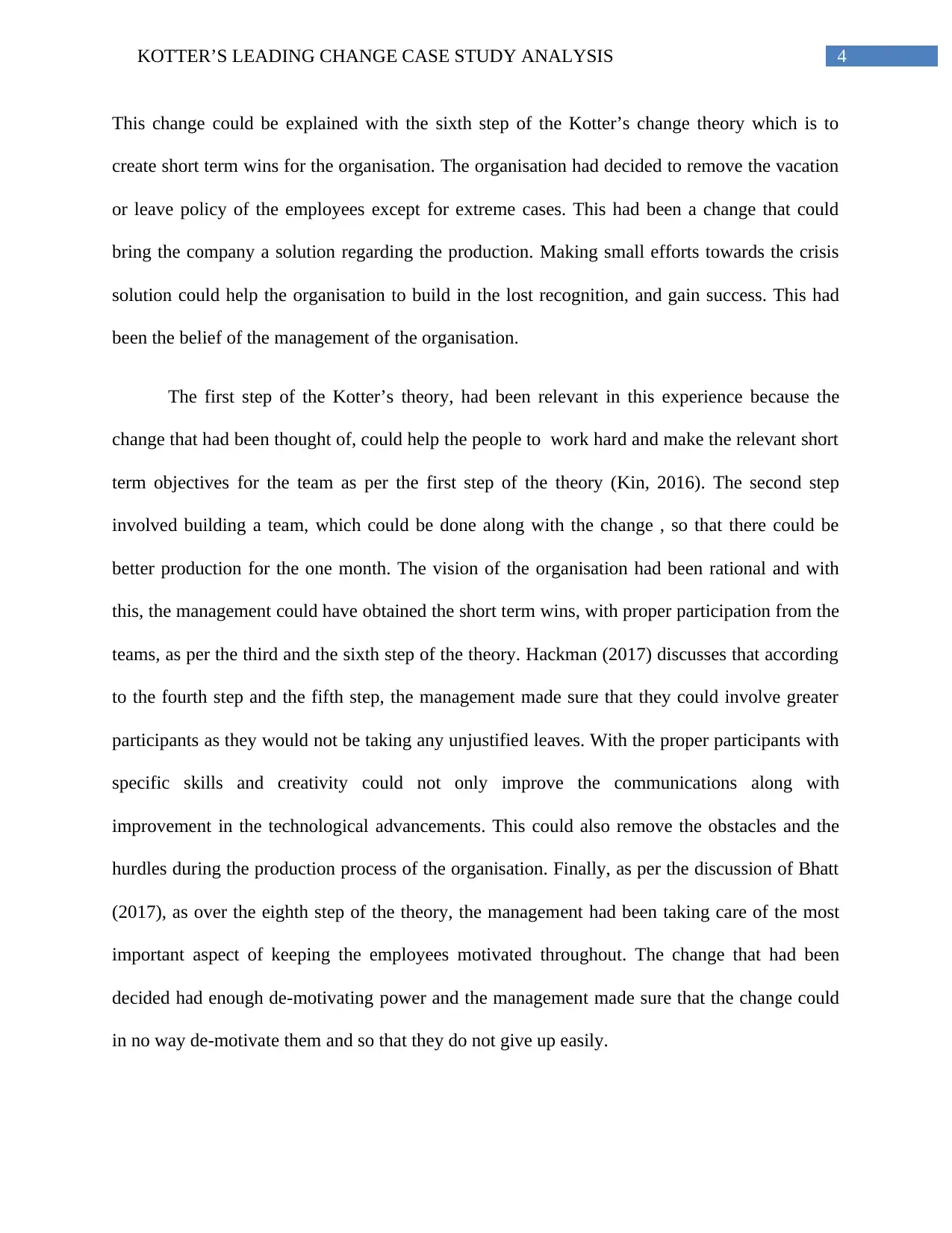
4KOTTER’S LEADING CHANGE CASE STUDY ANALYSIS
This change could be explained with the sixth step of the Kotter’s change theory which is to
create short term wins for the organisation. The organisation had decided to remove the vacation
or leave policy of the employees except for extreme cases. This had been a change that could
bring the company a solution regarding the production. Making small efforts towards the crisis
solution could help the organisation to build in the lost recognition, and gain success. This had
been the belief of the management of the organisation.
The first step of the Kotter’s theory, had been relevant in this experience because the
change that had been thought of, could help the people to work hard and make the relevant short
term objectives for the team as per the first step of the theory (Kin, 2016). The second step
involved building a team, which could be done along with the change , so that there could be
better production for the one month. The vision of the organisation had been rational and with
this, the management could have obtained the short term wins, with proper participation from the
teams, as per the third and the sixth step of the theory. Hackman (2017) discusses that according
to the fourth step and the fifth step, the management made sure that they could involve greater
participants as they would not be taking any unjustified leaves. With the proper participants with
specific skills and creativity could not only improve the communications along with
improvement in the technological advancements. This could also remove the obstacles and the
hurdles during the production process of the organisation. Finally, as per the discussion of Bhatt
(2017), as over the eighth step of the theory, the management had been taking care of the most
important aspect of keeping the employees motivated throughout. The change that had been
decided had enough de-motivating power and the management made sure that the change could
in no way de-motivate them and so that they do not give up easily.
This change could be explained with the sixth step of the Kotter’s change theory which is to
create short term wins for the organisation. The organisation had decided to remove the vacation
or leave policy of the employees except for extreme cases. This had been a change that could
bring the company a solution regarding the production. Making small efforts towards the crisis
solution could help the organisation to build in the lost recognition, and gain success. This had
been the belief of the management of the organisation.
The first step of the Kotter’s theory, had been relevant in this experience because the
change that had been thought of, could help the people to work hard and make the relevant short
term objectives for the team as per the first step of the theory (Kin, 2016). The second step
involved building a team, which could be done along with the change , so that there could be
better production for the one month. The vision of the organisation had been rational and with
this, the management could have obtained the short term wins, with proper participation from the
teams, as per the third and the sixth step of the theory. Hackman (2017) discusses that according
to the fourth step and the fifth step, the management made sure that they could involve greater
participants as they would not be taking any unjustified leaves. With the proper participants with
specific skills and creativity could not only improve the communications along with
improvement in the technological advancements. This could also remove the obstacles and the
hurdles during the production process of the organisation. Finally, as per the discussion of Bhatt
(2017), as over the eighth step of the theory, the management had been taking care of the most
important aspect of keeping the employees motivated throughout. The change that had been
decided had enough de-motivating power and the management made sure that the change could
in no way de-motivate them and so that they do not give up easily.
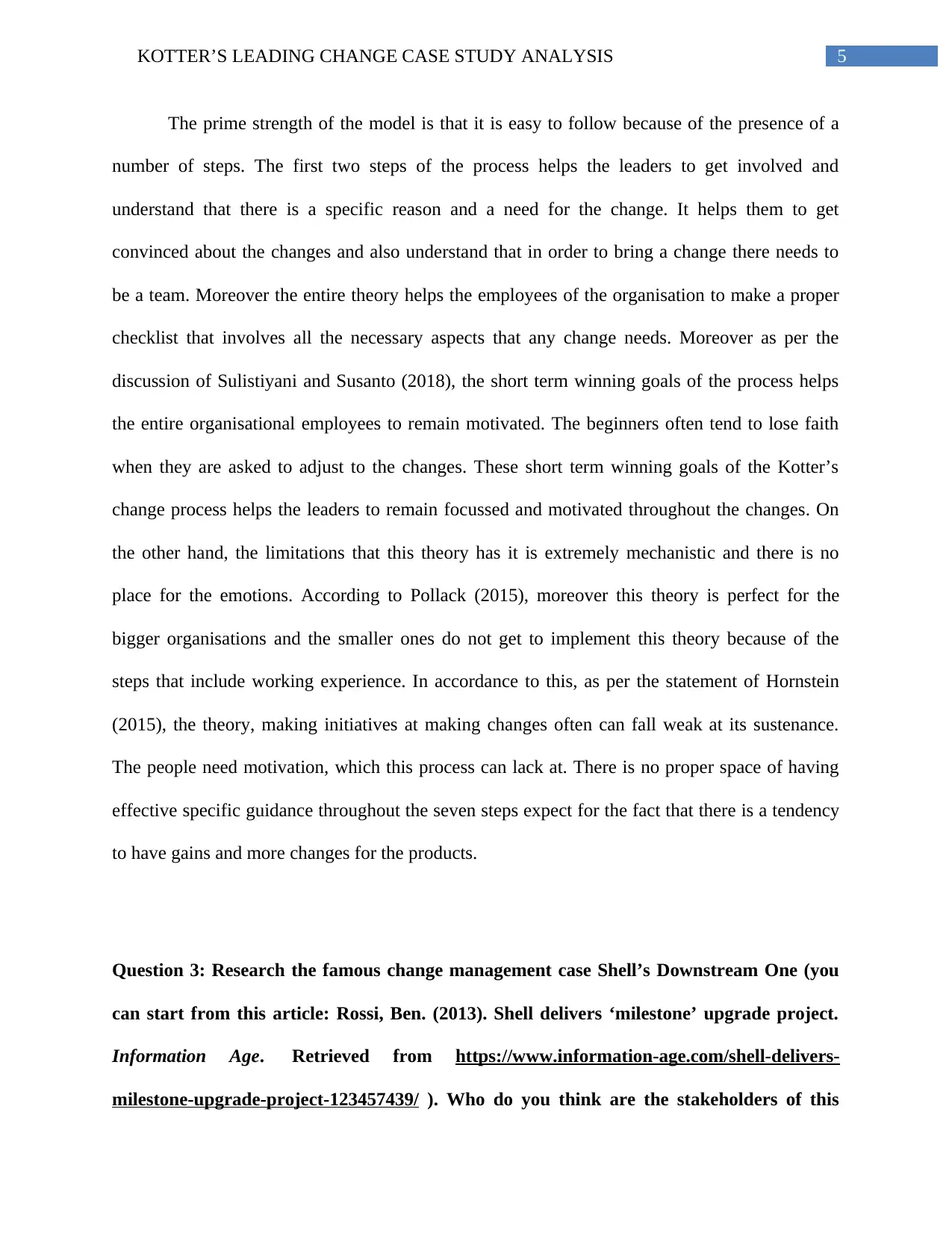
5KOTTER’S LEADING CHANGE CASE STUDY ANALYSIS
The prime strength of the model is that it is easy to follow because of the presence of a
number of steps. The first two steps of the process helps the leaders to get involved and
understand that there is a specific reason and a need for the change. It helps them to get
convinced about the changes and also understand that in order to bring a change there needs to
be a team. Moreover the entire theory helps the employees of the organisation to make a proper
checklist that involves all the necessary aspects that any change needs. Moreover as per the
discussion of Sulistiyani and Susanto (2018), the short term winning goals of the process helps
the entire organisational employees to remain motivated. The beginners often tend to lose faith
when they are asked to adjust to the changes. These short term winning goals of the Kotter’s
change process helps the leaders to remain focussed and motivated throughout the changes. On
the other hand, the limitations that this theory has it is extremely mechanistic and there is no
place for the emotions. According to Pollack (2015), moreover this theory is perfect for the
bigger organisations and the smaller ones do not get to implement this theory because of the
steps that include working experience. In accordance to this, as per the statement of Hornstein
(2015), the theory, making initiatives at making changes often can fall weak at its sustenance.
The people need motivation, which this process can lack at. There is no proper space of having
effective specific guidance throughout the seven steps expect for the fact that there is a tendency
to have gains and more changes for the products.
Question 3: Research the famous change management case Shell’s Downstream One (you
can start from this article: Rossi, Ben. (2013). Shell delivers ‘milestone’ upgrade project.
Information Age. Retrieved from https://www.information-age.com/shell-delivers-
milestone-upgrade-project-123457439/ ). Who do you think are the stakeholders of this
The prime strength of the model is that it is easy to follow because of the presence of a
number of steps. The first two steps of the process helps the leaders to get involved and
understand that there is a specific reason and a need for the change. It helps them to get
convinced about the changes and also understand that in order to bring a change there needs to
be a team. Moreover the entire theory helps the employees of the organisation to make a proper
checklist that involves all the necessary aspects that any change needs. Moreover as per the
discussion of Sulistiyani and Susanto (2018), the short term winning goals of the process helps
the entire organisational employees to remain motivated. The beginners often tend to lose faith
when they are asked to adjust to the changes. These short term winning goals of the Kotter’s
change process helps the leaders to remain focussed and motivated throughout the changes. On
the other hand, the limitations that this theory has it is extremely mechanistic and there is no
place for the emotions. According to Pollack (2015), moreover this theory is perfect for the
bigger organisations and the smaller ones do not get to implement this theory because of the
steps that include working experience. In accordance to this, as per the statement of Hornstein
(2015), the theory, making initiatives at making changes often can fall weak at its sustenance.
The people need motivation, which this process can lack at. There is no proper space of having
effective specific guidance throughout the seven steps expect for the fact that there is a tendency
to have gains and more changes for the products.
Question 3: Research the famous change management case Shell’s Downstream One (you
can start from this article: Rossi, Ben. (2013). Shell delivers ‘milestone’ upgrade project.
Information Age. Retrieved from https://www.information-age.com/shell-delivers-
milestone-upgrade-project-123457439/ ). Who do you think are the stakeholders of this
⊘ This is a preview!⊘
Do you want full access?
Subscribe today to unlock all pages.

Trusted by 1+ million students worldwide
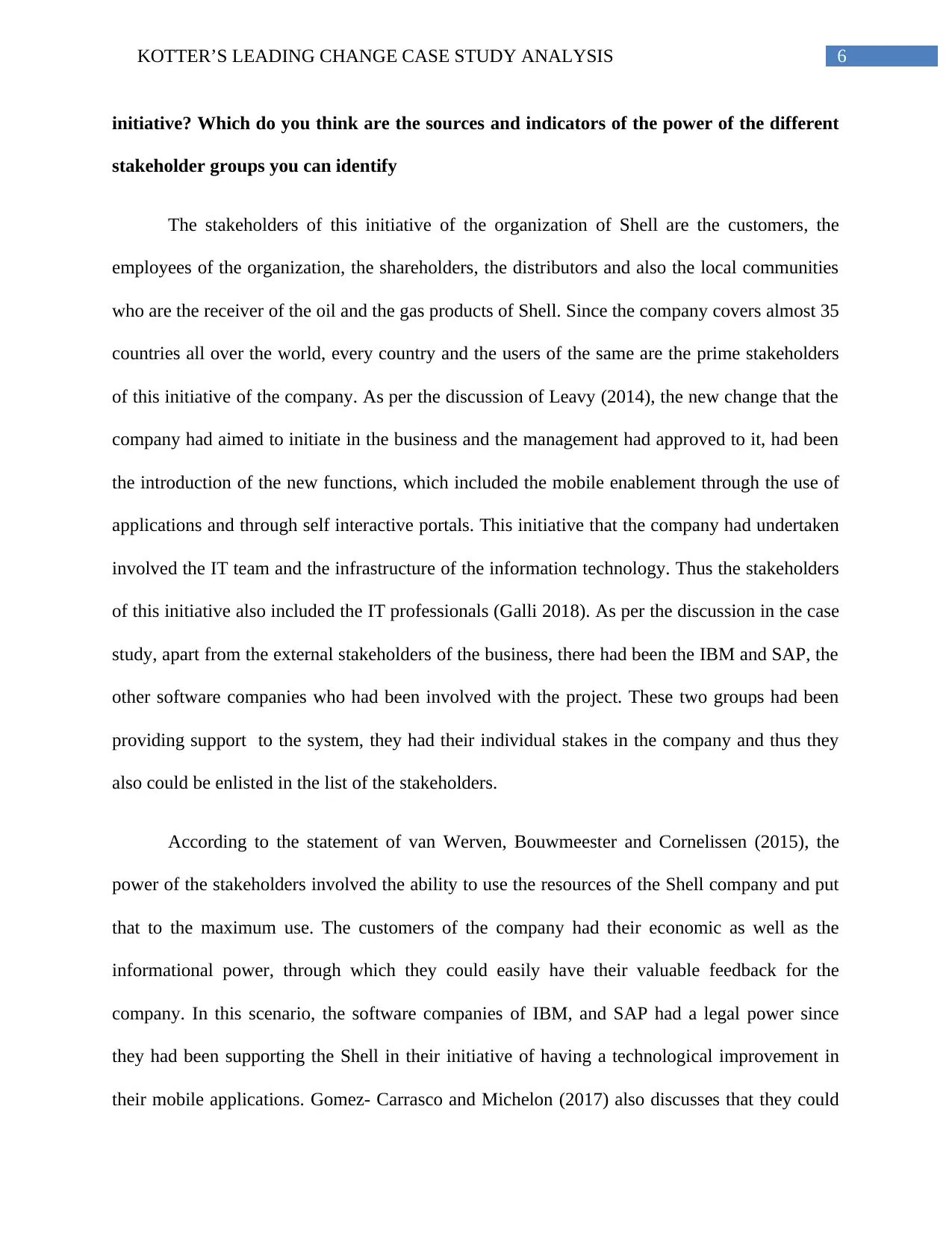
6KOTTER’S LEADING CHANGE CASE STUDY ANALYSIS
initiative? Which do you think are the sources and indicators of the power of the different
stakeholder groups you can identify
The stakeholders of this initiative of the organization of Shell are the customers, the
employees of the organization, the shareholders, the distributors and also the local communities
who are the receiver of the oil and the gas products of Shell. Since the company covers almost 35
countries all over the world, every country and the users of the same are the prime stakeholders
of this initiative of the company. As per the discussion of Leavy (2014), the new change that the
company had aimed to initiate in the business and the management had approved to it, had been
the introduction of the new functions, which included the mobile enablement through the use of
applications and through self interactive portals. This initiative that the company had undertaken
involved the IT team and the infrastructure of the information technology. Thus the stakeholders
of this initiative also included the IT professionals (Galli 2018). As per the discussion in the case
study, apart from the external stakeholders of the business, there had been the IBM and SAP, the
other software companies who had been involved with the project. These two groups had been
providing support to the system, they had their individual stakes in the company and thus they
also could be enlisted in the list of the stakeholders.
According to the statement of van Werven, Bouwmeester and Cornelissen (2015), the
power of the stakeholders involved the ability to use the resources of the Shell company and put
that to the maximum use. The customers of the company had their economic as well as the
informational power, through which they could easily have their valuable feedback for the
company. In this scenario, the software companies of IBM, and SAP had a legal power since
they had been supporting the Shell in their initiative of having a technological improvement in
their mobile applications. Gomez- Carrasco and Michelon (2017) also discusses that they could
initiative? Which do you think are the sources and indicators of the power of the different
stakeholder groups you can identify
The stakeholders of this initiative of the organization of Shell are the customers, the
employees of the organization, the shareholders, the distributors and also the local communities
who are the receiver of the oil and the gas products of Shell. Since the company covers almost 35
countries all over the world, every country and the users of the same are the prime stakeholders
of this initiative of the company. As per the discussion of Leavy (2014), the new change that the
company had aimed to initiate in the business and the management had approved to it, had been
the introduction of the new functions, which included the mobile enablement through the use of
applications and through self interactive portals. This initiative that the company had undertaken
involved the IT team and the infrastructure of the information technology. Thus the stakeholders
of this initiative also included the IT professionals (Galli 2018). As per the discussion in the case
study, apart from the external stakeholders of the business, there had been the IBM and SAP, the
other software companies who had been involved with the project. These two groups had been
providing support to the system, they had their individual stakes in the company and thus they
also could be enlisted in the list of the stakeholders.
According to the statement of van Werven, Bouwmeester and Cornelissen (2015), the
power of the stakeholders involved the ability to use the resources of the Shell company and put
that to the maximum use. The customers of the company had their economic as well as the
informational power, through which they could easily have their valuable feedback for the
company. In this scenario, the software companies of IBM, and SAP had a legal power since
they had been supporting the Shell in their initiative of having a technological improvement in
their mobile applications. Gomez- Carrasco and Michelon (2017) also discusses that they could
Paraphrase This Document
Need a fresh take? Get an instant paraphrase of this document with our AI Paraphraser
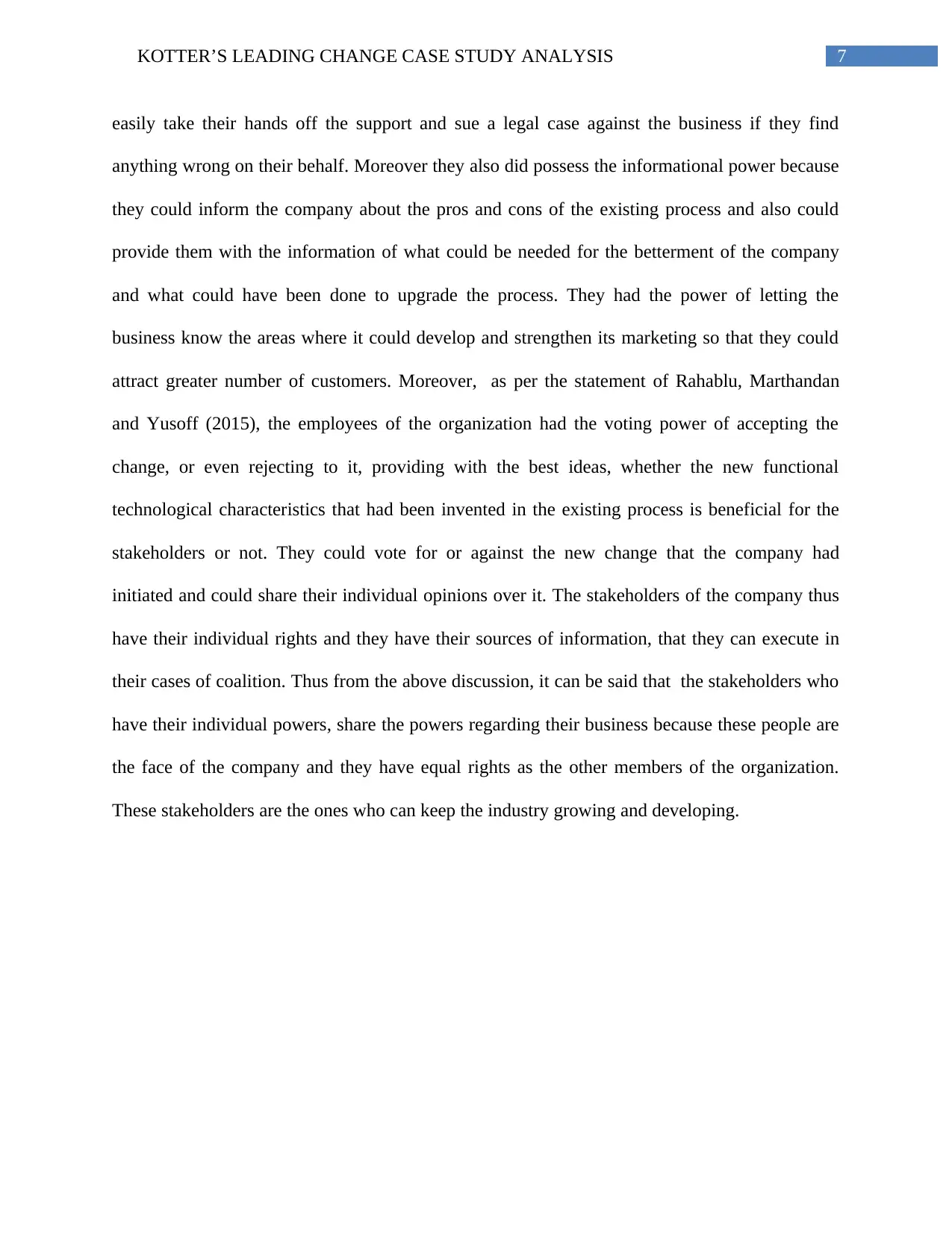
7KOTTER’S LEADING CHANGE CASE STUDY ANALYSIS
easily take their hands off the support and sue a legal case against the business if they find
anything wrong on their behalf. Moreover they also did possess the informational power because
they could inform the company about the pros and cons of the existing process and also could
provide them with the information of what could be needed for the betterment of the company
and what could have been done to upgrade the process. They had the power of letting the
business know the areas where it could develop and strengthen its marketing so that they could
attract greater number of customers. Moreover, as per the statement of Rahablu, Marthandan
and Yusoff (2015), the employees of the organization had the voting power of accepting the
change, or even rejecting to it, providing with the best ideas, whether the new functional
technological characteristics that had been invented in the existing process is beneficial for the
stakeholders or not. They could vote for or against the new change that the company had
initiated and could share their individual opinions over it. The stakeholders of the company thus
have their individual rights and they have their sources of information, that they can execute in
their cases of coalition. Thus from the above discussion, it can be said that the stakeholders who
have their individual powers, share the powers regarding their business because these people are
the face of the company and they have equal rights as the other members of the organization.
These stakeholders are the ones who can keep the industry growing and developing.
easily take their hands off the support and sue a legal case against the business if they find
anything wrong on their behalf. Moreover they also did possess the informational power because
they could inform the company about the pros and cons of the existing process and also could
provide them with the information of what could be needed for the betterment of the company
and what could have been done to upgrade the process. They had the power of letting the
business know the areas where it could develop and strengthen its marketing so that they could
attract greater number of customers. Moreover, as per the statement of Rahablu, Marthandan
and Yusoff (2015), the employees of the organization had the voting power of accepting the
change, or even rejecting to it, providing with the best ideas, whether the new functional
technological characteristics that had been invented in the existing process is beneficial for the
stakeholders or not. They could vote for or against the new change that the company had
initiated and could share their individual opinions over it. The stakeholders of the company thus
have their individual rights and they have their sources of information, that they can execute in
their cases of coalition. Thus from the above discussion, it can be said that the stakeholders who
have their individual powers, share the powers regarding their business because these people are
the face of the company and they have equal rights as the other members of the organization.
These stakeholders are the ones who can keep the industry growing and developing.
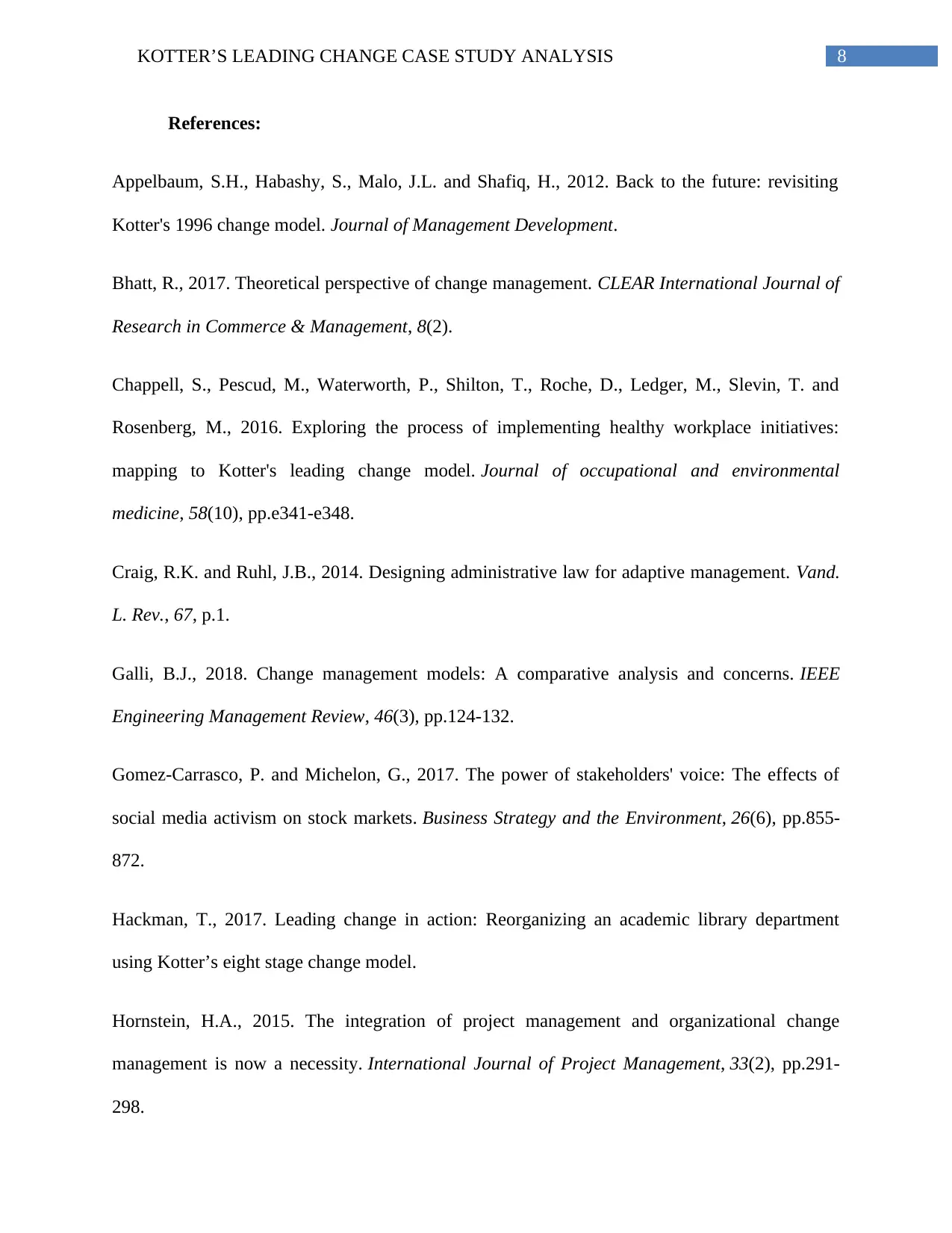
8KOTTER’S LEADING CHANGE CASE STUDY ANALYSIS
References:
Appelbaum, S.H., Habashy, S., Malo, J.L. and Shafiq, H., 2012. Back to the future: revisiting
Kotter's 1996 change model. Journal of Management Development.
Bhatt, R., 2017. Theoretical perspective of change management. CLEAR International Journal of
Research in Commerce & Management, 8(2).
Chappell, S., Pescud, M., Waterworth, P., Shilton, T., Roche, D., Ledger, M., Slevin, T. and
Rosenberg, M., 2016. Exploring the process of implementing healthy workplace initiatives:
mapping to Kotter's leading change model. Journal of occupational and environmental
medicine, 58(10), pp.e341-e348.
Craig, R.K. and Ruhl, J.B., 2014. Designing administrative law for adaptive management. Vand.
L. Rev., 67, p.1.
Galli, B.J., 2018. Change management models: A comparative analysis and concerns. IEEE
Engineering Management Review, 46(3), pp.124-132.
Gomez‐Carrasco, P. and Michelon, G., 2017. The power of stakeholders' voice: The effects of
social media activism on stock markets. Business Strategy and the Environment, 26(6), pp.855-
872.
Hackman, T., 2017. Leading change in action: Reorganizing an academic library department
using Kotter’s eight stage change model.
Hornstein, H.A., 2015. The integration of project management and organizational change
management is now a necessity. International Journal of Project Management, 33(2), pp.291-
298.
References:
Appelbaum, S.H., Habashy, S., Malo, J.L. and Shafiq, H., 2012. Back to the future: revisiting
Kotter's 1996 change model. Journal of Management Development.
Bhatt, R., 2017. Theoretical perspective of change management. CLEAR International Journal of
Research in Commerce & Management, 8(2).
Chappell, S., Pescud, M., Waterworth, P., Shilton, T., Roche, D., Ledger, M., Slevin, T. and
Rosenberg, M., 2016. Exploring the process of implementing healthy workplace initiatives:
mapping to Kotter's leading change model. Journal of occupational and environmental
medicine, 58(10), pp.e341-e348.
Craig, R.K. and Ruhl, J.B., 2014. Designing administrative law for adaptive management. Vand.
L. Rev., 67, p.1.
Galli, B.J., 2018. Change management models: A comparative analysis and concerns. IEEE
Engineering Management Review, 46(3), pp.124-132.
Gomez‐Carrasco, P. and Michelon, G., 2017. The power of stakeholders' voice: The effects of
social media activism on stock markets. Business Strategy and the Environment, 26(6), pp.855-
872.
Hackman, T., 2017. Leading change in action: Reorganizing an academic library department
using Kotter’s eight stage change model.
Hornstein, H.A., 2015. The integration of project management and organizational change
management is now a necessity. International Journal of Project Management, 33(2), pp.291-
298.
⊘ This is a preview!⊘
Do you want full access?
Subscribe today to unlock all pages.

Trusted by 1+ million students worldwide
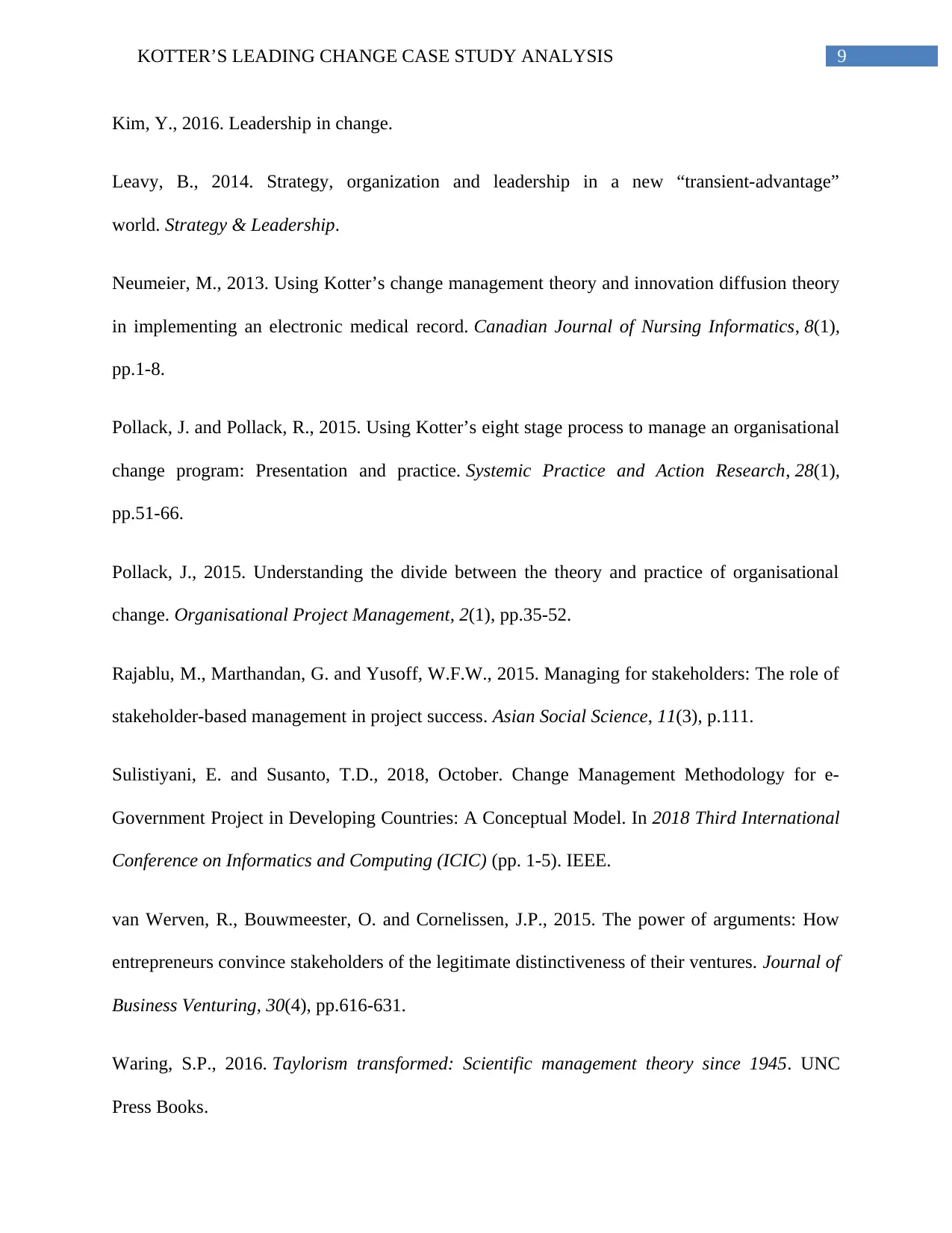
9KOTTER’S LEADING CHANGE CASE STUDY ANALYSIS
Kim, Y., 2016. Leadership in change.
Leavy, B., 2014. Strategy, organization and leadership in a new “transient-advantage”
world. Strategy & Leadership.
Neumeier, M., 2013. Using Kotter’s change management theory and innovation diffusion theory
in implementing an electronic medical record. Canadian Journal of Nursing Informatics, 8(1),
pp.1-8.
Pollack, J. and Pollack, R., 2015. Using Kotter’s eight stage process to manage an organisational
change program: Presentation and practice. Systemic Practice and Action Research, 28(1),
pp.51-66.
Pollack, J., 2015. Understanding the divide between the theory and practice of organisational
change. Organisational Project Management, 2(1), pp.35-52.
Rajablu, M., Marthandan, G. and Yusoff, W.F.W., 2015. Managing for stakeholders: The role of
stakeholder-based management in project success. Asian Social Science, 11(3), p.111.
Sulistiyani, E. and Susanto, T.D., 2018, October. Change Management Methodology for e-
Government Project in Developing Countries: A Conceptual Model. In 2018 Third International
Conference on Informatics and Computing (ICIC) (pp. 1-5). IEEE.
van Werven, R., Bouwmeester, O. and Cornelissen, J.P., 2015. The power of arguments: How
entrepreneurs convince stakeholders of the legitimate distinctiveness of their ventures. Journal of
Business Venturing, 30(4), pp.616-631.
Waring, S.P., 2016. Taylorism transformed: Scientific management theory since 1945. UNC
Press Books.
Kim, Y., 2016. Leadership in change.
Leavy, B., 2014. Strategy, organization and leadership in a new “transient-advantage”
world. Strategy & Leadership.
Neumeier, M., 2013. Using Kotter’s change management theory and innovation diffusion theory
in implementing an electronic medical record. Canadian Journal of Nursing Informatics, 8(1),
pp.1-8.
Pollack, J. and Pollack, R., 2015. Using Kotter’s eight stage process to manage an organisational
change program: Presentation and practice. Systemic Practice and Action Research, 28(1),
pp.51-66.
Pollack, J., 2015. Understanding the divide between the theory and practice of organisational
change. Organisational Project Management, 2(1), pp.35-52.
Rajablu, M., Marthandan, G. and Yusoff, W.F.W., 2015. Managing for stakeholders: The role of
stakeholder-based management in project success. Asian Social Science, 11(3), p.111.
Sulistiyani, E. and Susanto, T.D., 2018, October. Change Management Methodology for e-
Government Project in Developing Countries: A Conceptual Model. In 2018 Third International
Conference on Informatics and Computing (ICIC) (pp. 1-5). IEEE.
van Werven, R., Bouwmeester, O. and Cornelissen, J.P., 2015. The power of arguments: How
entrepreneurs convince stakeholders of the legitimate distinctiveness of their ventures. Journal of
Business Venturing, 30(4), pp.616-631.
Waring, S.P., 2016. Taylorism transformed: Scientific management theory since 1945. UNC
Press Books.
Paraphrase This Document
Need a fresh take? Get an instant paraphrase of this document with our AI Paraphraser
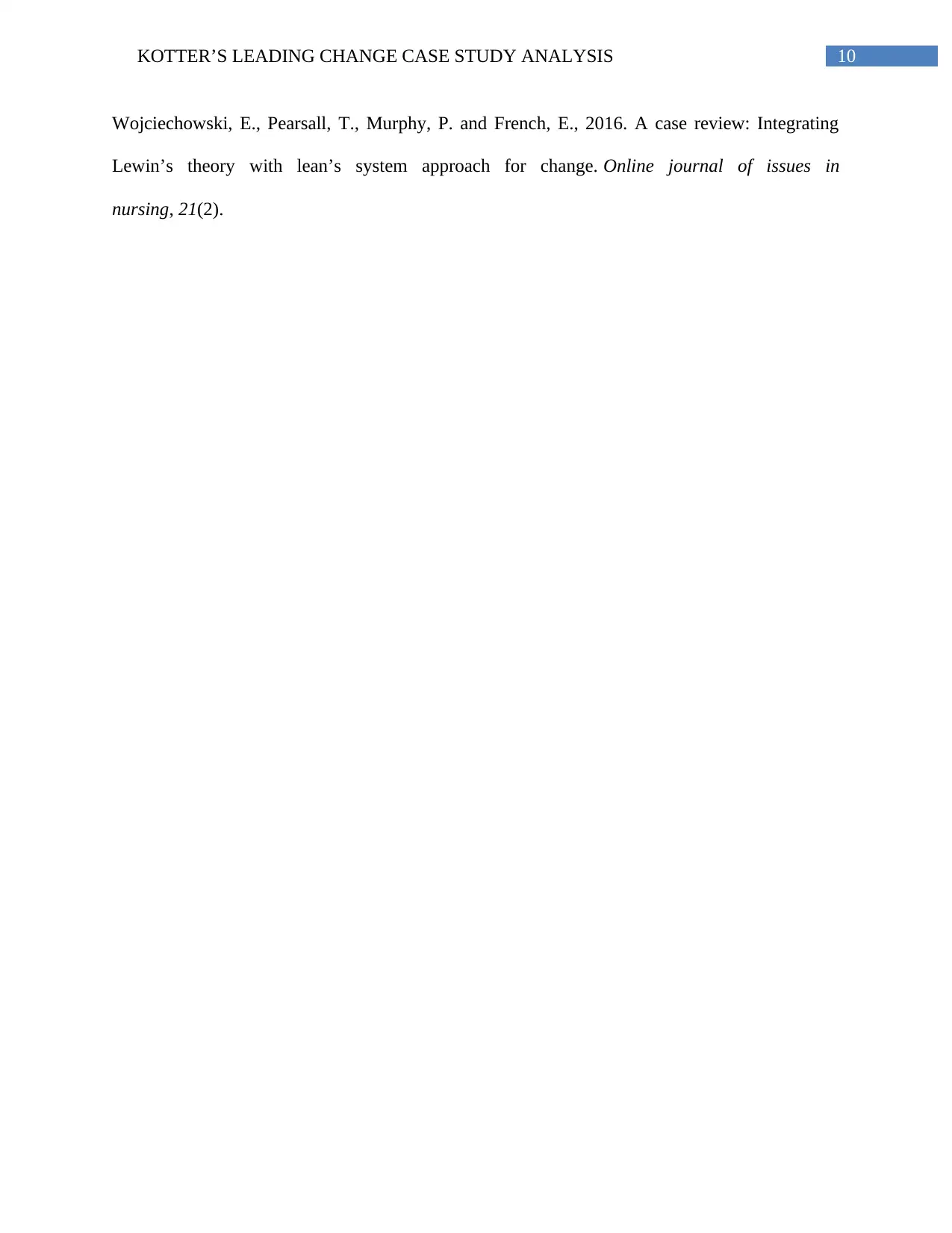
10KOTTER’S LEADING CHANGE CASE STUDY ANALYSIS
Wojciechowski, E., Pearsall, T., Murphy, P. and French, E., 2016. A case review: Integrating
Lewin’s theory with lean’s system approach for change. Online journal of issues in
nursing, 21(2).
Wojciechowski, E., Pearsall, T., Murphy, P. and French, E., 2016. A case review: Integrating
Lewin’s theory with lean’s system approach for change. Online journal of issues in
nursing, 21(2).
1 out of 11
Related Documents
Your All-in-One AI-Powered Toolkit for Academic Success.
+13062052269
info@desklib.com
Available 24*7 on WhatsApp / Email
![[object Object]](/_next/static/media/star-bottom.7253800d.svg)
Unlock your academic potential
Copyright © 2020–2025 A2Z Services. All Rights Reserved. Developed and managed by ZUCOL.





